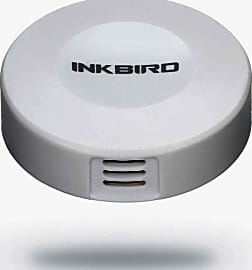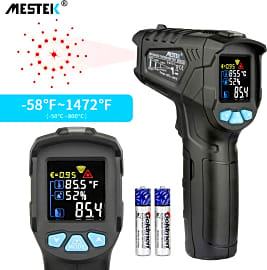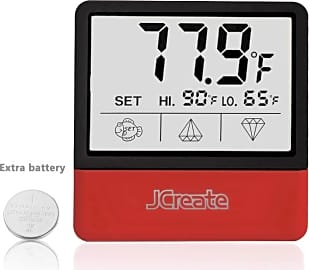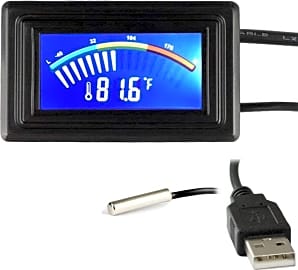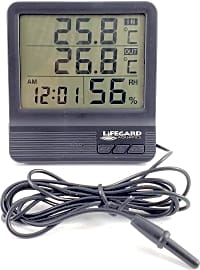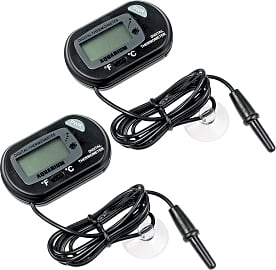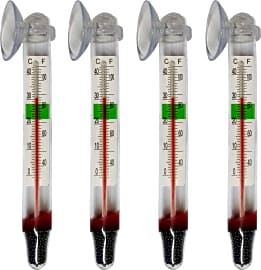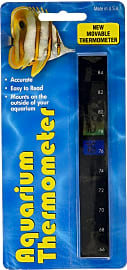The 10 Best Aquarium Thermometers

This wiki has been updated 34 times since it was first published in October of 2016. If you want your fish and other aquatic critters to thrive, then you have to maintain a stable temperature in their environment. Aquarium thermometers are an easy way to help do that, and they require little or no maintenance. Our selections for this category include both digital and analog models, and some of our high-end choices can even be monitored remotely via an app. When users buy our independently chosen editorial recommendations, we may earn commissions to help fund the Wiki.
Editor's Notes
April 13, 2021:
This list looked to still be in good shape, and so we moved through this round of updates without a lot of significant changes. The only major modification we made was removing the Pet Magasin, which wasn’t available at the time of this writing, and replacing it with the Lomodo 4 Pack.
Our new pick from Lomodo joined the LCR Hallcrest A-1005 in being one of the few analog options featured on this list. Compared to digital alternatives, it might be a bit difficult to read, and it definitely isn’t high-tech enough to boast app connectivity or any such similar conveniences, but we still thought it was worth including, due largely to its rock-bottom price, which is affordable enough to make it worth considering as a backup unit to support your fancy digital purchase.
Note that options on this list are focused on devices intended to monitor, and in some cases report, temperature readings, but none of our picks are equipped with provisions that make it possible for them to control your aquarium heater or aquarium chiller. If that’s what you’re after, then you might do better with our list of temperature controllers, but before making any purchases make sure that the option you’re choosing is suitable for use with aquariums.
March 26, 2020:
During this round of updates, while the Corner Biz Aquarium was removed due to availability issues, and the BOYU BT-08 due to its dismal rankings, we also decided to eliminate the American Thermal BC002008, JW Pet Company and General Tools AQ150, as we needed to make room for some exciting, high-end models, and we felt that our rankings already included similar, better-priced options.
Some of our new additions this time around include the Inkbird IBS-TH1 – a model that can be conveniently monitored via app, the Mestek Temperature Gun – an infrared-laser thermometer that’s great for monitoring the consistency of your water temperature, and the Capetsma Digital Stick-On – a smart-looking offering with a three-inch, transparent touch screen.
Some considerations for this category:
Installation: For this category, this isn’t a matter of inconvenience so much as it’s a matter of aesthetics. If you think a wire running into your aquarium and a probe dangling in your water is going to be an eyesore, then consider a surface-mountable option with a built-in sensor, like the Capetsma Digital Stick-On, the Pet Magasin or even the LCR Hallcrest A-1005. If you think a thermometer permanently mounted to the side of your aquarium is going to be an eyesore, consider an option that can easily be stored in a drawer and is designed for intermittent checking, like the Vee Gee Scientific or the Mestek Temperature Gun. The Keynice AP-185-BK is designed to be flush mounted, which might be impractical for most situations, but could offer an opportunity for a really slick, unobtrusive installation if your aquarium is set up in a nook or corner.
Legibility: These readings are no good to you if you can’t read them, so try to pick an option that’s as legible as possible. While models with smaller numbers, like the LCR Hallcrest A-1005, can be hard to make out from a distance or in the dark, others with oversized displays, like the Capetsma Digital Stick-On, are much easier to keep an eye on. The Inkbird IBS-TH1 has no integrated display, and must be monitored via app, which brings me to my next point:
Connectivity: Like so many devices that we never thought would need internet access, aquarium thermometers with app connectivity are beginning to appear on the market, allowing you to track your water temperature remotely, and keep track of any fluctuations that occur over time. The Inkbird IBS-TH1 is one such model, and we’ve also included the Plus version at the top of our list, which essentially appears to be the same thermometer, but with a built-in LCD screen.
Keeping Your Fish Happy And Healthy
Digital aquarium thermometers are battery-operated devices consisting of an external display that is directly connected to a probe placed inside the tank.
Taking care of pets is a big responsibility. Large animals require a lot of human interaction and mental stimulation to keep them happy in their environments. That said, a smaller-sized pet doesn't necessarily require any less attention or monitoring. Sustaining aquatic life within an enclosed ecosystem, for example, carries similar responsibilities. In addition to maintaining a heater, constant awareness of the temperature inside your aquarium is integral to the health of your fish. In a natural ecosystem, a complex combination of weather, chemical, and geological processes have allowed animals to adapt to certain conditions over millions of years. By contrast, the aquarium isn't equipped with these natural processes, hence a fishkeeper's responsibility for keeping a closed tank system as stable as possible on their own. One way to do this is to monitor the tank's internal temperature using a thermometer.
In its most traditional form, a thermometer is a temperature-measuring instrument with a hermetically-sealed and graduated glass tube containing either mercury or alcohol. The mercury is designed to contract and expand from inside the tube as the surrounding temperature fluctuates.
But why is the aquarium thermometer so important and will it help me keep my fish healthy? Temperature accuracy and stability go hand-in-hand within a successful closed ecosystem. It's important to remember that an aquarium is artificial because it is man-made and separated from naturally-existing environments found in lakes or oceans. This means that, as a fishkeeper, you must recreate the same living conditions for your fish that they would ordinarily encounter when in their natural habitats. In order to accomplish this, both the aquarium heater and thermometer will be necessary to maintain temperature stability, while alerting you to potential problems before they become harmful to the animals. It's also important to realize that fish are cold-blooded creatures, which means they maintain the same body temperature as their environment. Therefore, major temperature changes can have a significant impact on their overall metabolism and ability to feed.
Three most common types of aquarium thermometer include stick-on, floating or standing, and digital. Also referred to as the liquid crystal display thermometer, the stick-on variety is the most inexpensive of all three options and popular for use in freshwater aquariums. As its name suggests, it "sticks" to the outside walls of a fish tank where it displays the temperature in a specific color.
Typically made from glass, floating or standing thermometers are placed directly inside the aquarium, which allows them to provide a more direct measurement of the internal water temperature. These thermometers can be equipped with suction cups for attaching to the inside walls of a tank, they can be suspended from a submerged clip, they can be left to float freely in the drink, and some are even equipped with weights for sinking to the bottom of an aquarium to "stand" and take more accurate readings.
Digital aquarium thermometers are battery-operated devices consisting of an external display that is directly connected to a probe placed inside the tank. Digital thermometers are usually the most accurate of all three types and can easily take readings from any location inside the aquarium.
Maintaining A Stable Mini Ecosystem
Always be aware of the optimal temperature ranges for the fish in your aquarium. For example, a neon tetra has greater sensitivity to temperature fluctuations and prefers an environment between 68 and 75 degrees Fahrenheit.
If you have large and highly-active fish swimming in your tank, a stick-on or digital thermometer will be a more practical and durable option than the floating variety.
Depending on the size of your aquarium and species of fish inhabiting it, you'll need to decide which type of thermometer is best. If you have large and highly-active fish swimming in your tank, a stick-on or digital thermometer will be a more practical and durable option than the floating variety. A major benefit to the digital thermometer is the convenient placement of its probe in virtually any location inside the tank. Its display is also unobtrusively mounted outside the aquarium. Many digital thermometers are also designed to display temperature values in both Fahrenheit and Celsius with an accuracy within 0.1 degrees. If you invest in a digital thermometer, make sure its display is backlit, so you can see it during the day and at night. Additionally, consider a thermometer with a built-in audible alert to inform you when the water temperature is too high or low.
Don't discount the floating thermometer from consideration, as many can be placed in multiple locations and are often equipped with colored bars indicating a safe temperature zone. While a floating thermometer isn't going to give you the same pinpoint temperature accuracy as the digital model, it's still an inexpensive alternative and a great choice for kids or those new to fishkeeping.
A Brief History Of Aquarium Thermometers
The earliest thermometers were actually referred to as thermoscopes, which were rudimentary thermometers without a scale. A thermoscope would only show temperature differences and not specific values. Galileo Galilei developed the first water thermoscope in 1593. Italian inventor Santorio Santorio was the first to put a numerical scale on his thermoscope by 1612.
Italian inventor Santorio Santorio was the first to put a numerical scale on his thermoscope by 1612.
It wasn't until 1714 when German physicist Daniel Gabriel Fahrenheit would develop the first modern mercury thermometer, followed by the introduction of his standard temperature scale in 1724.
The first medical thermometer used to take a person's temperature was invented by English physician, Sir Thomas Allbutt in 1867.
Following the growing popularity for the fishkeeping hobby after World War II, both the aquarium heater and thermometer became integral tools for sustaining aquatic life, as the aquarium thermometer could help inform how well the heater was keeping an accurate temperature.
Modern thermometers offer improved accuracy, compact size, and a wide selection of designs and placement options to accommodate fish tanks of any size or water type.


